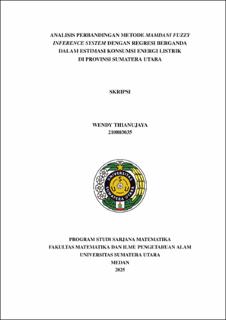Analisis Perbandingan Metode Mamdani Fuzzy Inference System dengan Regresi Berganda dalam Estimasi Konsumsi Energi Listrik di Provinsi Sumatera Utara
Comparative Analysis of Mamdani Fuzzy Inference System and Multiple Regression Methods for Estimating Electricity Energy Consumption in North Sumatra Province

Date
2025Author
Thianujaya, Wendy
Advisor(s)
Gultom, Parapat
Hasibuan, Citra Dewi
Metadata
Show full item recordAbstract
The continuously increasing demand for electricity presents a significant challenge
in energy supply, particularly because electricity cannot be stored on a large scale.
Therefore, accurate estimation methods are essential to avoid shortages or surpluses in
power capacity, both of which can lead to substantial losses. This study aims to compare
the accuracy of electricity consumption estimation in North Sumatra Province using
the Mamdani Fuzzy Inference System (FIS) and multiple linear regression methods,
both in their standard forms and after being modified with the Walk Forward Validation
(WFV) approach and basic assumptions (AD). The independent variables used include
Gross Regional Domestic Product (GRDP), population, and number of customers. The
results show that all methods applied (fuzzy AD, fuzzy WFV, standard fuzzy, regression
AD, regression WFV, and standard regression) demonstrated very high accuracy, with
MAPE values below 10%. The regression WFV method achieved the highest accuracy
with a MAPE of 0.83% and MSE of 11,137.51, followed by regression AD, standard
regression, fuzzy AD, standard fuzzy, and fuzzy WFV. The analysis of the influence of
the independent variables reveals that GRDP and the number of customers have a
positive impact, while population has a negative impact on electricity consumption.
This study also confirms that the Mamdani FIS can be applied to linear data, provided
that appropriate approaches such as walk forward validation and basic assumptions
are used. The findings recommend regression WFV as the most suitable method for
predicting electricity consumption, particularly for linear data, while Mamdani FIS can
be employed for both linear and non-linear data with the appropriate logic framework.
Collections
- Undergraduate Theses [1490]
